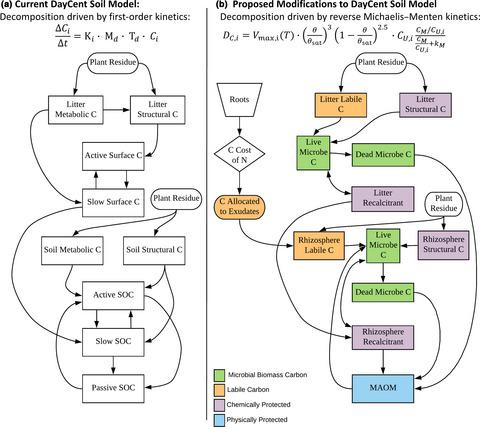当前位置:
X-MOL 学术
›
GCB Bioenergy
›
论文详情
Our official English website, www.x-mol.net, welcomes your
feedback! (Note: you will need to create a separate account there.)
21st‐century biogeochemical modeling: Challenges for Century‐based models and where do we go from here?
Global Change Biology Bioenergy ( IF 5.9 ) Pub Date : 2020-08-25 , DOI: 10.1111/gcbb.12730 Danielle Berardi 1, 2 , Edward Brzostek 1, 3 , Elena Blanc‐Betes 4 , Brian Davison 5 , Evan H. DeLucia 1, 4 , Melannie D. Hartman 1, 6 , Jeffrey Kent 1, 2 , William J. Parton 1, 6 , Debasish Saha 7 , Tara W. Hudiburg 1, 2
Global Change Biology Bioenergy ( IF 5.9 ) Pub Date : 2020-08-25 , DOI: 10.1111/gcbb.12730 Danielle Berardi 1, 2 , Edward Brzostek 1, 3 , Elena Blanc‐Betes 4 , Brian Davison 5 , Evan H. DeLucia 1, 4 , Melannie D. Hartman 1, 6 , Jeffrey Kent 1, 2 , William J. Parton 1, 6 , Debasish Saha 7 , Tara W. Hudiburg 1, 2
Affiliation

|
21st‐century modeling of greenhouse gas (GHG) emissions from bioenergy crops is necessary to quantify the extent to which bioenergy production can mitigate climate change. For over 30 years, the Century‐based biogeochemical models have provided the preeminent framework for belowground carbon and nitrogen cycling in ecosystem and earth system models. While monthly Century and the daily time‐step version of Century (DayCent) have advanced our ability to predict the sustainability of bioenergy crop production, new advances in feedstock generation, and our empirical understanding of sources and sinks of GHGs in soils call for a re‐visitation of DayCent's core model structures. Here, we evaluate current challenges with modeling soil carbon dynamics, trace gas fluxes, and drought and age‐related impacts on bioenergy crop productivity. We propose coupling a microbial process‐based soil organic carbon and nitrogen model with DayCent to improve soil carbon dynamics. We describe recent improvements to DayCent for simulating unique plant structural and physiological attributes of perennial bioenergy grasses. Finally, we propose a method for using machine learning to identify key parameters for simulating N2O emissions. Our efforts are focused on meeting the needs for modeling bioenergy crops; however, many updates reviewed and suggested to DayCent will be broadly applicable to other systems.
中文翻译:

21世纪的生物地球化学建模:基于世纪的模型所面临的挑战,我们从何而来?
为了量化生物能源生产可以减轻气候变化的程度,有必要对21世纪生物能源作物的温室气体(GHG)排放进行建模。30多年来,基于Century的生物地球化学模型为生态系统和地球系统模型中地下碳和氮的循环提供了卓越的框架。尽管每月的Century和Century(DayCent)的每日时间步长版本已经提高了我们预测生物能源作物生产可持续性的能力,原料生产的新进展以及我们对土壤中GHGs的源和汇的经验性了解,参观DayCent的核心模型结构。在这里,我们通过对土壤碳动力学,微量气体通量以及干旱和与年龄相关的对生物能源作物生产力的影响进行建模来评估当前的挑战。我们建议将基于微生物过程的土壤有机碳和氮模型与DayCent耦合,以改善土壤碳动力学。我们描述了DayCent的最新改进,用于模拟多年生生物能源草的独特植物结构和生理特性。最后,我们提出了一种使用机器学习识别关键参数以模拟N的方法2 O排放。我们的工作重点是满足对生物能源作物建模的需求;但是,许多经过审查并建议给DayCent的更新将广泛应用于其他系统。
更新日期:2020-08-25
中文翻译:

21世纪的生物地球化学建模:基于世纪的模型所面临的挑战,我们从何而来?
为了量化生物能源生产可以减轻气候变化的程度,有必要对21世纪生物能源作物的温室气体(GHG)排放进行建模。30多年来,基于Century的生物地球化学模型为生态系统和地球系统模型中地下碳和氮的循环提供了卓越的框架。尽管每月的Century和Century(DayCent)的每日时间步长版本已经提高了我们预测生物能源作物生产可持续性的能力,原料生产的新进展以及我们对土壤中GHGs的源和汇的经验性了解,参观DayCent的核心模型结构。在这里,我们通过对土壤碳动力学,微量气体通量以及干旱和与年龄相关的对生物能源作物生产力的影响进行建模来评估当前的挑战。我们建议将基于微生物过程的土壤有机碳和氮模型与DayCent耦合,以改善土壤碳动力学。我们描述了DayCent的最新改进,用于模拟多年生生物能源草的独特植物结构和生理特性。最后,我们提出了一种使用机器学习识别关键参数以模拟N的方法2 O排放。我们的工作重点是满足对生物能源作物建模的需求;但是,许多经过审查并建议给DayCent的更新将广泛应用于其他系统。











































 京公网安备 11010802027423号
京公网安备 11010802027423号